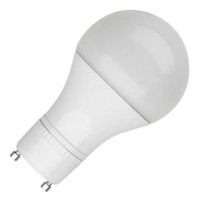This post has been updated from its original 2008 version.
You may have heard of the GU24 bulb and wondered what they are. Available in both CFL and LED, these bulbs have a different base than the standard screw base bulbs. GU24 bulbs have 2 pins protruding from the base instead of the usual screw in base. To install the bulb, you would insert the pins into the corresponding holes in the socket and twist the light bulb and lock it into place.
So why would you want to use a bulb with this base? What are the advantages?
- The GU24 bulb is self-ballasted i.e., the ballast portion of the bulb is already attached to the bulb and is easy to replace.
- The overall length of the bulb is shorter since the ballast and the bulb are in one unit
- You can easily change the wattage of the bulb, unlike pin base bulbs which require the socket to be changed for different wattages of bulbs. This offers more flexibility.
- The size and shape of socket is similar to an incandescent socket so it’s great for homes.
- A standard GU24 Bulb is interchangeable between manufacturers.
- The LED GU24 Bulb is long lasting with an expected life of 25,000 hours of life which decreases the need for regular replacement. At Conservation Mart we offer these bulbs in a variety of color temperatures ranging from 2700K to 4000K.
So next time you’re in the market for a lighting fixture, consider one that utilizes a GU24 base bulb.
Shop now for GU24 base bulbs>>>





